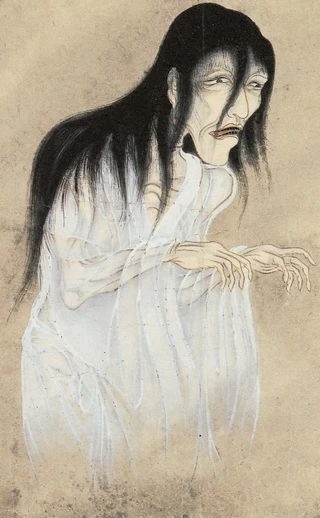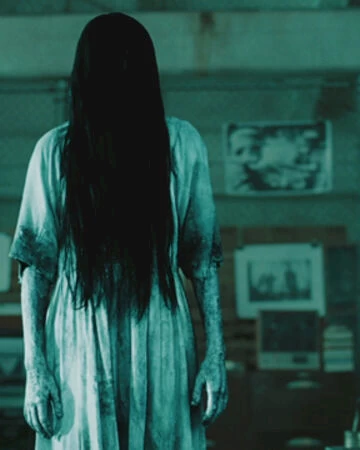

Ghosts of the World - Onryō
Many cultures from different countries have different myths/folklores or spirits to fear or worship. This short series looks at the different ghosts from around the World! Today's ghost is the Onryō
Onryō
While some (particular a younger generation) may associate the Onryō with a character ghost from the popular game Phasmophobia, it actually comes centuries ago from Japanese folklore. Traditionally, the Onryō is a type of yūrei which means ghost. The Onryō translates to mean vengeful spirit. It is also called a revenge spirit and is thought to be a spirit who feels they were wronged and their sole purpose is to seek revenge. Often it is described as a spirit that was killed or driven to their death which has left them full of anger. They then take this anger out on the living either murdering them or influencing them to their own demise as a form of revenge for what happened to them. The image depicting an Onryō is actually one of the images most recognisable within paranormal pop culture. We will get to that shortly.

The Onryō by Sawaki Suushi (佐脇嵩之,)
The origins of the folklore behind the Onryō cannot be traced back to a specific time, however, it is thought to be around the 7th or 8th century as this is where the first written accounts appear. It is possible that the belief predates this and just wasn't written about. The belief in the Onryō is a part of the Shintō which is the indigenous faith of the Japanese people and it is as old as Japan itself. The word Shintō, literally means 'the way of kami' (generally sacred or divine power, specifically the various gods or deities). Shinto traditions and practices can be traced back to the oldest extant chronicle in Japan from the 8th century, the Kojiki, as well as the second oldest book of classical Japanese history, the Nihon Shoki. These ancient Japanese writings are historical records of a collection of Japanese mythology and native beliefs. The earliest record of possession by an Onryō is chronicled in Shoku Nihongi, an imperially-commissioned Japanese history text from 797. It detailed the events leading to the death of Genbō a Japanese scholar-monk and bureaucrat of the Imperial Court at Nara. His rival Fujiwara Hirotsugu was said to be the cause of his death in the form of a vengeful Onryō . Hirotsugu died in a failed insurrection historically known as the 'Fujiwara no Hirotsugu Rebellion'. Shoku Nihongi states that Fujiwara Hirotsugu’s soul was the cause of Genbō’s demise.
Yotsuya Kaidan
The most famous Onryō stems from what has become one of the most famous Japanese ghost stories. The story of Oiwa and Tamiya Iemon was first staged in July of 1825 as a part of Kabuki Theatre - a classical form of Japanese dance mixed with drama. It has been adapted over 30 times for Japanese Horror movies and is one of the leading influences on how the Onryō is perceived.
Iemon, a disarmed samurai, hopes to raise his rank by marrying Oiwa, daughter of Yotsuya Samon. After begging the latter to allow him to marry his daughter and having suffered a violent refusal, the mad samurai kills Samon. A low-life criminal, Naosuke, witnesses the murder and offers to help Iemon hide the crime in exchange for his help. Indeed, the latter has his sights on Oiwa’s sister, Osode, already promised to another. They conspire together to accuse other bandits of the murder of the father and Naosuke pushes Osode’s fiancé from the top of a waterfall to get rid of him. The two men who managed to pass themselves off as heroes having nothing to do with the murders, each of them manage to marry the daughters.
Much later, married Iemon and Oiwa live together with their newborn child. They live in poverty, Iemon is not happy and Oiwa suffers that his father has not yet been avenged. The samurai begins to fall in love with a younger woman, Oume, the daughter of a rich doctor. At the same time, Naosuke who lives with Osode, is also tired of living in poverty. The story here differs in two different versions, in the one we see in the Kabuki play, Oume is madly in love with Iemon and her family poisons Oiwa in order to make marriage possible. In another version, it is Naosuke who sees in the marriage of Iemon and Oume a perfect opportunity to become rich and gives poison to the samurai so that he poisons his wife. The fact is that this poison, in each version, disfigures terribly the latter who ends up dying and taking her son's life with hers. Her body is dumped in the river by the samurai and Naosuke.
Soon after that, Iemon marries Oume but on their wedding day, the avenging ghost of Oiwa comes back to haunt the samurai and urges him, victim of hallucinations, to murder both his new wife and the father of the bride. The ghost is also harassing Naosuke and his wife. The latter is surprised by the visit of her former fiancé who, having survived the fall, accusing her of adultery. Distraught, she manages to push her two husbands to give her death, leaving a letter in which she confesses to Naosuke that she is in fact his younger sister, causing the latter’s suicide, who confesses his crimes to the former fiancé.
Iemon, who fled to the mountain, tries to fish but it is not fishes but the bodies of all those he killed that appear before him in the pond. Constantly harassed by the ghost of Oiwa, he sinks into madness until he meets the former fiancé of Osode, who will finally obtain his revenge by killing Iemon.
http://www.peak-experience-japan.com/blog/652
Over time the story has been changed and adapted and the play staged today bears little resemblance to the original, however, the concept of the vengeful ghost has remained the same throughout all these years.
Photo from the movie Ringu (1998) Japan - the visual representation of the Onryō was mirrored here from its days in Kabuki Theatre .
Interestingly, while there are tales of male Onryō, they are however not associated with revenge. Instead, their motive is driven by honour. The 'revenge' seems to be an exclusive trait of the female Onryō and the majority of the stories are focused on this female version. Perhaps it is a reflection of how women were viewed during the time and a point I am doing some research on which I will write about at a later time.
It is probably one of the most recognisable ghosts in pop culture thanks to the Kabuki theatre interpretation which brought to life the white dress and long dark hair covering the face as the symbol of the Onryō. This eventually transcended into Hollywood pop culture in the form of American remakes of Japanese horror movies like The Ring (A remake of Ringu -1998) bringing the revengeful Onryō to the attention of the mainstream World. In fact, the movie The Ring was such a success that more remakes based on similar Japanese horror movies were made such as The Grudge.

Photo from the movie The Ring (2002) US Version
In the American movie The Ring (2002), Samara forever cemented the Onryō as the symbol of vengeful ghosts. In fact, extending from this, many people unknowingly associate this kind of image with any sort of negative female spirit they feel they have encountered showing just how much folklore and pop culture influence our perception of paranormal events. Often if you ask someone to describe the female ghost they saw, they will say long dark hair and a white gown. It has similarities to that of the image of the 'woman in white' type ghost reported at most haunted locations which is something to be discussed at another time.
So how do you defeat or 'cleanse' an Onryō? Folklore suggests that you can never banish or get rid of an Onryō, the best you can do is to appease it. It is very similar to that of the Hungry Ghost in Chinese culture where every year an offering is made of food, gifts and money in return for the spirit to leave them alone for the year.
Belief in ghosts is something that we share on a global scale, yet our interpretation is somewhat different. In some cultures, they are celebrated, and in others, they are feared. The Onryō most certainly falls into the latter. What I find most intriguing here is you have a figure born from folklore that morphed into theatrical entertainment which led to mainstream movies forever influencing the paranormal landscape. The Kabuki ghost stories were written as entertainment as while the first Onryō ghost story 'Yotsuya Kaidan' written for the theatre was fiction, elements of it were based on real murders. The first involved two servants who murdered their masters. They were caught and executed on the same day. The second murder was from a samurai who discovered his concubine was having an affair with a servant. The samurai had the faithless concubine and servant nailed to a wooden board and thrown into the Kanda River. Adding these real murders into the original ghost story blurred the lines between entertainment and reality and I feel this is the perfect representation of how the Onryō and perhaps the paranormal in general is now perceived. It can be difficult to know what is based on historical fact or reality and what has been embellished or made up to complete a story. The story becomes changed over time however the belief in the figure (in the case an Onryō) remains the same.
Of course, revenge ghosts are not exclusive to Japanese beliefs, and similar ghosts exist across the World. We will be exploring them and their origins and influences throughout this series.
References
https://www.atlasobscura.com/articles/monster-mythology-onryo
https://yokai.com/onryou/
https://www.japanese-wiki-corpus.org/culture/Onryo%20(Revengeful%20Ghost).html
https://moonmausoleum.com/onryo-the-vengeful-japanese-spirit/
http://www.peak-experience-japan.com/blog/652
If you enjoy LLIFS, consider buying me a book (otherwise known as buy me a coffee but I don't drink coffee and I LOVE books). Your donation helps to fund the LLIFS website so everyone can continue to access great paranormal content and resources for FREE!

Top pages with similar subjects
Don't forget to follow the Facebook page for regular updates
Join the mailing list to receive weekly updates of NEW articles. Never miss an article again!
Buy the latest and past issues Haunted Magazine
Check out the books written by LLIFS
Comments
-
Natalie Vujovich 2 years ago
Loving this series and especially this one. I have to admit that the black hair and the white dress is my scariest ghost. The originals of these movies - be they Japanese or Korean - are definitely creepier and scarier than the American remakes. Looking forward to the rest of the stories coming up.